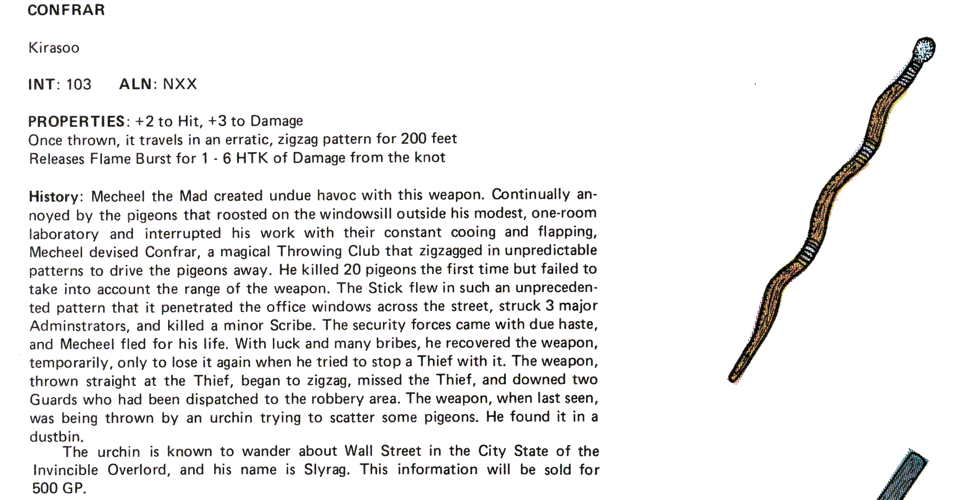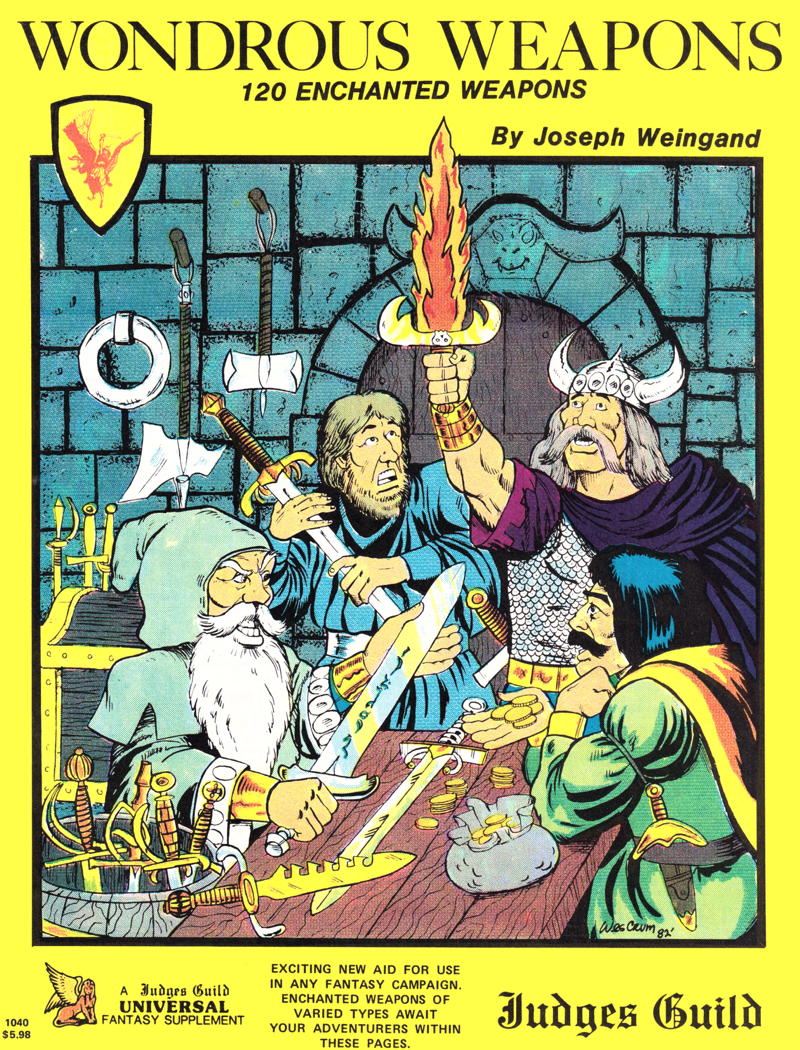Wondrous Weapons of Ancient Days
Wondrous Weapons, by Joseph Weingand, is a collection of weird and often unusable weapons for fantasy games. It’s also a fascinating glimpse into old-school treasure and old-school play styles.
Wes Crum’s front cover is very reminiscent of Dave Trampier’s treasure illustration in the AD&D Players Handbook, in that there are a variety of emotions expressed on the character faces. It is less technically adept than the back cover (and far less than even the worst of Trampier’s illustrations) but also more fun than the back cover. Neither are up to the level of Trampier, of course.
The entries use the Judges Guild universal system to present the stats of the weapons, but without the one-or-two page explanation that usually accompanies it. And you really do need the explanation to decipher the stats. What is an INT of 184? An ALN of NEX or NGC?
These were not easy to decipher without the conversion summary. An INT—or intelligence—of 184 means an intelligence of 18, which can be used four times a day “without checking for stress damage”. The ALN is the alignment, and it’s vaguely Freudian. The first two letters indicate the alignment that most AD&D players would recognize. The third letter “indicates only a suppressed desire”. So, NEX is Neutral Evil with no suppressed alignment, while NGC is Neutral Good with a suppressed desire to be Chaotic.
The proliferation of universal systems was a fascinating byproduct of the times. They were rarely universal. They were meant solely to make it easier to convert to AD&D without saying AD&D. You can see that in Wondrous Weapons, where the stat numbers—mostly intelligence—tend to be in the 3 to 18 range. And, of course, the use of an alignment system of Chaotic/Neutral/Lawful and Good/Neutral/Evil.
The need for a universal system that really only applies to one game, when publishing supplemental material, appears to have been based on either a poor understanding of copyright law or a very good understanding of the litigious nature of the gaming industry. If you’re a small company, after all—and Judges Guild was very small—knowing you’re right doesn’t matter if you have neither the money nor the inclination to defend yourself.
Most early gaming companies were gamers first, companies second. A letter from a corporate lawyer, especially in pre-Internet days, was a very frightening and demoralizing experience.
The book itself features “interesting” design choices. There are no chapters. The organization, in fact, is very odd. The entries are sort of in alphabetic order, by type of weapon; that is, the swords are bundled together and the axes come at the front, and so on. The organization-by-type is marked in the table of contents, but not in the content itself. The weapons just slide into the next type.
Another interesting feature is that this book is partially in color. All of the weapons have an illustration of the weapon, usually a very generic sword, or mace, or whatever. Three of the 17x11 sheets used in this 8.5x11 book include colored illustrations on one side of the sheet, resulting in six pages of color: pages 8/57, 9/56, and 16/49. It looks like Judges Guild was experimenting with ways to include color without increasing the cost of the book too much.
All of the weapons are very idiosyncratic, and would have to be modified for any game that isn’t the author’s. But they’re also very good jumping-off points for weapon ideas and weapon background ideas. Every entry has an origin and most also have a reason for their current location.
The location is usually in some general area of Judges Guild’s known world. The proprietor of the weapons shop will sell that information, and prices are given for each. But surprisingly few of these locations are Judges Guild dungeons. The only one I saw was Twilightstar, in the Glory Hole Dwarven Mine. Fearfar was noted as in the Witches Court Marshes, which might count—it’s a location, not a dungeon, but it was a Judges Guild module.

Under K, we have a kirasoo named Confrar. Not the most useful of weapons, but not the strangest in this collection either!
Some of the weapons probably came from personal campaigns and reflect the desires of the players or the inclinations of the dungeon masters. A lot of the weapons are noted as shrinking to dagger-size, so that they can be more easily concealed and, often, also used as daggers.
One of the shrinking weapons, Winsun, is notable for an interesting quirk that I’m surprised isn’t more common: its powers change according to the season. In the winter it’s a cold weapon, and in the summer a heat weapon. In the spring and fall it only has its bonuses to fall back on.
Tolkien popularized “moon runes”, letters that could only be discerned under a particular phase of the moon. Why not magic items that change with the moon? Or have special effects on New Year’s Day or between the death of one monarch and the coronation of the next? There are all sorts of interesting ways to make a magical weapon follow current events or the changes of nature.
Lovesword is another hidden gem. It is a powerful magic sword with what amounts to a very cool curse: it was made by a magic-user who was in love with a specific fighter. One of its enchantments “causes wielder to become enamored of creator of the Sword”. The magic-user gave the sword to the fighter, and, according to the story, it worked, but both the magic-user and the fighter are now dead and the sword is in the wild. Anyone who wields it will get a powerful weapon and a love that cannot be fulfilled because the target has been dead for centuries.
Personalized curses—or once-beneficial features that have gone awry—are a very good idea for magic items. A weapon that causes the wielder to search out a long-defeated enemy, or influences them to visit an abandoned castle or city or nation, would be cool variations on this theme. How about a weapon dating from before a major treaty, focused on the defeat of a nation that was then an enemy but is now an ally? Or a weapon meant for use by a once-ally that is now an enemy, against a once-enemy that is now an ally!
The back of the book has a series of tables for creating special weapons. They are far more usable than the similar tables in the other book I bought in this set, Island Book 1. The tables are numbered, so that you know where to start and how to proceed, and the table entries are filled with references to “see Sub Table 1H” and so on.
There is one odd quirk: clearly, you’re supposed to use tables 1 and then proceed to table 2. Are you, however, supposed to always proceed to table 3, “Construction”? While there are no references to “see Table 3”—which makes it look like table 3 is a top-level table like tables 1 and 2—all of the results from table 3 are unusual in some way. All weapons that use this table are either of an unusual material, have unusual decoration, or are gem- or jewel- studded.
Thus creating an orichalcrum lariat that can cut through warm metal. Which is, of course, very cool. The assumption could well be that all magical weapons feature unusual construction in some way. They might not be made from an unusual material, but will at least feature an unusual decoration or be studded with gems and/or jewels.
Whether the weapon is a wooden sword, or an iron sword studded with bloodstones, the magic items created from this table will be recognizable, and it may be that that is its purpose.
In response to Island Book 1 and old-school tables: Judges Guild Island Book 1 is a fascinating playground on which to place a sea-going adventure or campaign. It’s also a great example of the usefulness and wildness of old-school encounter tables.
- Copyright and game rules
- Game rules are specifically exempted from copyright restrictions in the United States. But open content remains useful for gamers, because it allows for easier re-use, easier improvement, and helps improve the long-term viability of a game.
- Island Book 1 and old-school tables
- Judges Guild Island Book 1 is a fascinating playground on which to place a sea-going adventure or campaign. It’s also a great example of the usefulness and wildness of old-school encounter tables.
- The Judges Guild Universal System at The Acaeum
- “The Judges Guild Universal Role Playing Adventures are designed for use with all game systems. They require a separate rules system for use. The categories of statistics listed here are carefully selected to be directly applicable to the majority of the published rule systems but should not be considered the only statistics open for use.”

